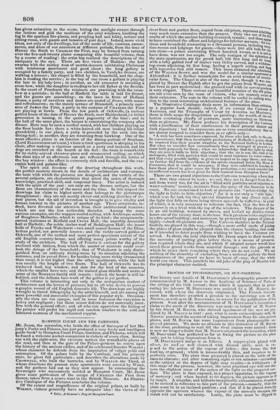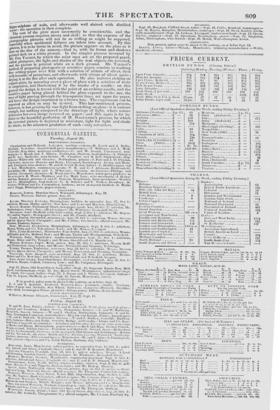PROCESS OF PHOTOGRAPHY, Olt SUN-PAINTING.
Tine history and details of M. DAGyEttim's photographic process were communicated by M. Aliso° to the Academy of Sciences of Paris, at the sitting of the 19th instant ; from which it appears, that in prose- cuting his labours 11. llsougaia: was assisted by a M. NIEPCE, de- ceased, with whom the discovery originated. The French Govern- ment has therefore awarded a pension to the surviving son of M, N1EPCE, as well as to M. DAGUERRE, in return for the publication of the process. Soon after the announcement of M. Dscceaue's invention, a claim to the merit of the discovery was made on behalf of 11. Nuirce by his friend M. BAITER, who showed specimens of the new art pros duced by M. NLEPCE 1111827 : and, what is more extraordinary still, M, E PCE possessed the means of taking impressions from his sun ;graven plates, and M. 13surnt has some impressions from photographic en- graved pictures. We made no allusion to this statement of M. BAUER at the time, preferring to wait till the rival claims were settled : there is now no longer a doubt that 31. Nigeee originated the invention, which M. DADUERRE has perfected so far as fixing the picture on the plate only, not in taking impressions from it. M. DAGUERRE'S recipe is as follows. A copper-plate plated with silver, its sin f .ce well cleansaci with diluted nitric acid, is ex- pesed to the action of the vapour of iodine : this forms the first coating, or ground ; which is inconceivably thin, and requires to be perfectly even. The plate thus prepared is placed on the table of the camera obseura ; and after remaining eight or ten minutes—according as the subject or the degree of light may require—is withdrawn : at this stage of the process, however, the most practised eye will not dis- cern the slightest trace of the action of the light on the prepared sur- face. The plate is then exposed, in a proper apparatus, to the vapour of mercury ; and when heated to 60 degrees, the picture appears as if by magic. A singular, and hitherto inexplicable circumstance, requires to be noticed in reference to this part of the process,—namely, that the plate must be in an inclined position ; and that if it be placed directly opposite the aperture whence the vapour of the mercury escapes, the result will not be satisfactory. Lastly, the plate must be dipped la
hippo sulphate of soda, and afterwards well sluiced with distilled rater: the operation is then complete.
The cost of the plate must necessarily be considerable, and the chemical process requires nicety and skill ; so that the expense of the 1) 6 hoteraphio pictures will not be so trifling as might be supposed, especially when accidental failures are taken into account. lly this process, ss is to be borne in mind, the picture appears on the plate as it does on the disc of the camera—that is, wills its forms and shadows painted dark on a white ground. In the simpler process invented by Dlr. Fox TALBOT, by which the solar rays act on the prepared paper, called photogenic, the light and shades of the real objects are reversed, and the picture is painted white on a dark ground. Mr. TArmoes method of preparing photogenic or sensitive paper, consists in washing fine writing-paper over first with a solution of nitrate of silver, then with bromide of potassium, and afterwards with nitrate of silver again ; drying it at the fire after each operation. He also imitates etching on copper-plate, by smearing over a piece of glass with a solution of resin in turpentine, and blackening it by the smoke of a candle on this ground the design is traced with the point of an etching-needle, and the sensitive paper being placed behind the glass exposed to the sun, the rays of light passing through the transparent lines, act upon the paper, and leave the design imprinted in a brown line. The experiment can be repeated as often as, may be desired. This last-mentioned process, however, is but printing by sun-light from etching on glass : it is curious enough, but nothing compared to the drawings of light, where nature delineates. her own image reversed on paper ; and this again is far in- ferior to the beautiful perfection of M. DAutmunE's process, by which the external picture is depicted in miniature, light for light and shade for shade, to the minutest gradation of each—only colourless.



























 Previous page
Previous page